We may not have the course you’re looking for. If you enquire or give us a call on + 1-866 272 8822 and speak to our training experts, we may still be able to help with your training requirements.
Training Outcomes Within Your Budget!
We ensure quality, budget-alignment, and timely delivery by our expert instructors.
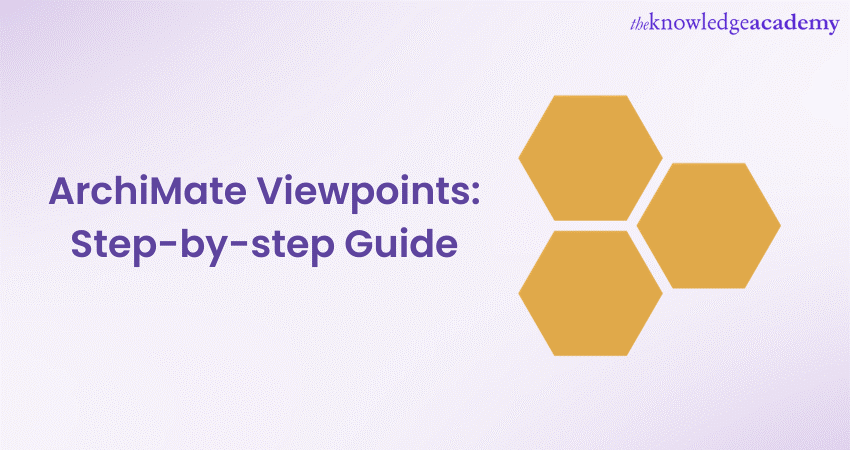
When talking about enterprise architecture, the ArchiMate framework has emerged as a powerful tool for visualising and communicating complex systems and their interrelationships. At the heart of this framework lies “ArchiMate Viewpoints" – specialised perspectives that provide insights into different aspects of an architecture.
According to Grand View Research, the enterprise architecture market size was valued at around $419 million in 2022 and is projected to reach $735.03 million in 2028. In this blog, we will take you through the world of ArchiMate Viewpoints, from understanding the basics to mastering advanced techniques.
Table of Contents
1) Understanding ArchiMate Viewpoints
2) Exploring ArchiMate Views and Viewpoints
3) Creating effective ArchiMate Views: A step-by-step guide
4) The full ArchiMate Viewpoints guide
5) Mastering the ArchiMate Layered Viewpoint
6) Advanced techniques for ArchiMate Viewpoints
7) Conclusion
Understanding ArchiMate Viewpoints
ArchiMate, a widely used enterprise architecture modelling language, empowers organisations to visualise, communicate, and manage complex systems and their intricate relationships. At the core of the ArchiMate framework lies the concept of "viewpoints," which are pivotal for representing architectural insights tailored to various stakeholders' perspectives. ArchiMate, developed by The Open Group, has become an indispensable tool for architects and stakeholders seeking to comprehend the intricate architecture of modern systems. It provides a standardised language to articulate and communicate architectural concepts, bridging the gap between technical complexity and meaningful understanding.
ArchiMate Viewpoints can be likened to lenses that architects employ to focus on specific facets of architecture. Each viewpoint provides a structured perspective that highlights specific elements and relationships within the system. By utilising various viewpoints, architects can create a coherent narrative that resonates with stakeholders possessing distinct interests and concerns.
In the landscape of enterprise architecture, where diverse stakeholders such as business executives, IT managers, and technical teams converge, viewpoints emerge as the linchpin for effective communication. Stakeholders often have distinct concerns and areas of focus, and viewpoints serve to customise architectural presentations, ensuring that each stakeholder group receives relevant insights. This tailored approach enhances communication and alignment, fostering a shared understanding of complex architectural landscapes.
ArchiMate 3 introduces an extensive range of viewpoints that span diverse layers and dimensions of enterprise architecture. These viewpoints are meticulously designed to capture the nuances of different architectural aspects. From the business layer, which delves into processes and roles, to the technology layer, which addresses infrastructure components, each viewpoint offers a unique vantage point into the architecture. The ArchiMate 3 viewpoints collectively form a structured toolkit that empowers architects to effectively communicate intricate concepts while accommodating the multifaceted nature of modern enterprises.
In essence, ArchiMate Viewpoints are the catalyst that transforms intricate Architecture Models into comprehensible and relevant insights. By aligning the architecture with the concerns of diverse stakeholders and employing a spectrum of viewpoints, enterprise architects facilitate informed decision-making and drive the successful execution of strategic initiatives. In the subsequent sections of this guide, we will delve deeper into the nuances of ArchiMate Viewpoints, equipping you with the knowledge to wield this powerful tool effectively.

Exploring ArchiMate Views and Viewpoints
Views are the visual representations of architectures derived from specific viewpoints. The relationship between views and viewpoints is symbiotic – viewpoints guide the creation of views, ensuring that the resulting diagrams address the concerns of specific stakeholders. A single architecture can yield a multitude of views, each tailored to different audiences. For instance, a complex banking system might be visualised using the Business Layer Viewpoint for executives, the Application Layer Viewpoint for IT teams, and the Motivation Viewpoint for strategic planners.
By seamlessly connecting viewpoints with views, ArchiMate empowers architects to communicate complex ideas effectively. This approach ensures that stakeholders receive information that aligns with their responsibilities and interests, fostering a deeper understanding of the architecture.
Types of ArchiMate Views: Core concepts and extensions
ArchiMate defines a set of core viewpoints that represent essential architectural dimensions. These core viewpoints include:
a) Business Layer Viewpoint: This viewpoint focuses on business processes, functions, and roles within an organisation. It helps architects comprehend how different business units collaborate and function.
b) Application Layer Viewpoint: Addressing software applications and their interactions, this viewpoint provides insights into the application landscape. Architects can assess dependencies, redundancies, and opportunities for optimisation.
c) Technology Layer Viewpoint: The technology viewpoint delves into infrastructure, platforms, and technology components. It aids in understanding the technological landscape supporting business operations.
ArchiMate also offers extension viewpoints designed to provide more specialised perspectives:
a) Motivation Viewpoint: This viewpoint captures stakeholder motivations, goals, and requirements. It aligns architectural decisions with the strategic objectives of the organisation. b
b) Implementation and Migration Viewpoint: Highlighting architectural change and transformation, this viewpoint aids in managing the evolution of systems over time.
c) Physical Elements Viewpoint: This perspective deals with the physical aspects of architecture, such as hardware components and physical locations.
By employing a combination of viewpoints, architects can offer a holistic view of architecture. This approach facilitates comprehensive analysis, enabling stakeholders to make informed decisions.
A significant strength of ArchiMate is its versatility in addressing diverse stakeholder concerns. By employing different viewpoints, architects can present the same architecture from multiple angles, catering to various audiences. For instance, the Business Layer Viewpoint would appeal to business stakeholders interested in process efficiency and alignment, while the Technology Layer Viewpoint would resonate with IT personnel, focusing on infrastructure and technology choices.
Moreover, combining multiple viewpoints offers a comprehensive analysis of an architecture. By examining the same system through different lenses, architects can uncover hidden complexities, interdependencies, and potential risks. This cross-viewpoint analysis enriches decision-making by providing a holistic understanding of the architecture's implications.
Master ArchiMate® 3.1 Training Course: Level 1 – Propel your architectural proficiency to new heights!
Creating effective ArchiMate Views: A step-by-step guide
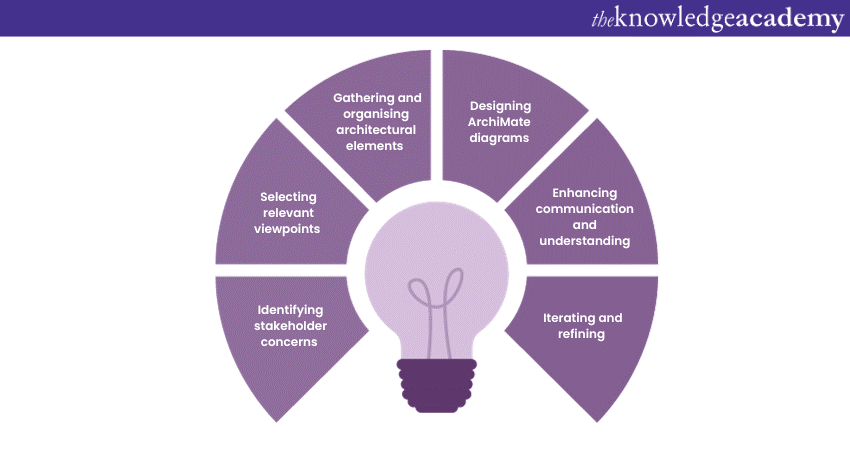
Architectural visualisation is a cornerstone of effective communication in the realm of enterprise architecture. Conveying intricate relationships, dependencies, and design decisions is crucial for aligning stakeholders, making informed decisions, and ensuring successful implementation. ArchiMate, a widely adopted enterprise architecture modelling language, offers a powerful toolset for creating such visual representations through its concept of "viewpoints." In this section, we will walk you through the step-by-step process of creating effective ArchiMate Views, empowering you to communicate your architectural vision with precision and impact.
a) Identifying stakeholder concerns
The journey of creating impactful ArchiMate Views begins with understanding the concerns and interests of the stakeholders. Engage with key stakeholders to gain insights into their specific information needs. What are their objectives? What aspects of the architecture are of highest the importance to them? By identifying and addressing these concerns, you ensure that your views resonate with the audience and provide valuable insights.
b) Selecting relevant viewpoints
Once you've gathered the concerns of various stakeholders, map them to the corresponding ArchiMate Viewpoints. ArchiMate offers a diverse set of viewpoints, each tailored to address specific architectural aspects. Select the viewpoints that align with the stakeholders' concerns, ensuring that your views provide relevant information and valuable insights to the intended audience.
c) Gathering and organising architectural elements
With the chosen viewpoints in mind, proceed to gather the relevant architectural elements that need to be included in the view. These elements could span across different layers of the architecture, such as business, application, and technology. Organise these elements logically, grouping related components together. This organisation enhances the clarity and coherence of the final view, making it easier for stakeholders to comprehend the presented information.
d) Designing ArchiMate diagrams for different viewpoints
Now that you have a clear understanding of stakeholders' concerns, selected appropriate viewpoints, and gathered architectural elements, it's time to translate this information into ArchiMate diagrams. Each viewpoint will dictate the arrangement and relationships of the elements. Leverage the visual language of ArchiMate to create clear and intuitive diagrams. Use symbols, colours, and annotations to convey the semantics of the architectural elements, relationships, and dependencies effectively.
e) Enhancing communication and understanding
Remember that the primary goal of creating ArchiMate Views is effective communication. Ensure that your diagrams are accessible and comprehensible to the intended audience. Avoid overloading diagrams with excessive details that might overwhelm stakeholders. Strike a balance between providing sufficient information and maintaining clarity. Use labels and annotations judiciously to clarify any complexities and provide context where needed.
f) Iterating and refining
Creating impactful ArchiMate Views is an iterative process. After designing the initial views, seek feedback from stakeholders. Are the concerns addressed effectively? Is the information presented in a clear and understandable manner? Incorporate feedback to refine your views, ensuring they accurately reflect stakeholder concerns and convey the intended insights.
The full ArchiMate Viewpoints guide
The ArchiMate framework offers a diverse set of viewpoints, each designed to provide a unique perspective on different aspects of enterprise architecture. These viewpoints act as lenses through which architects can analyse and communicate complex systems. Let's delve into the key viewpoints, understand their significance, and explore real-world examples that showcase their practical application.
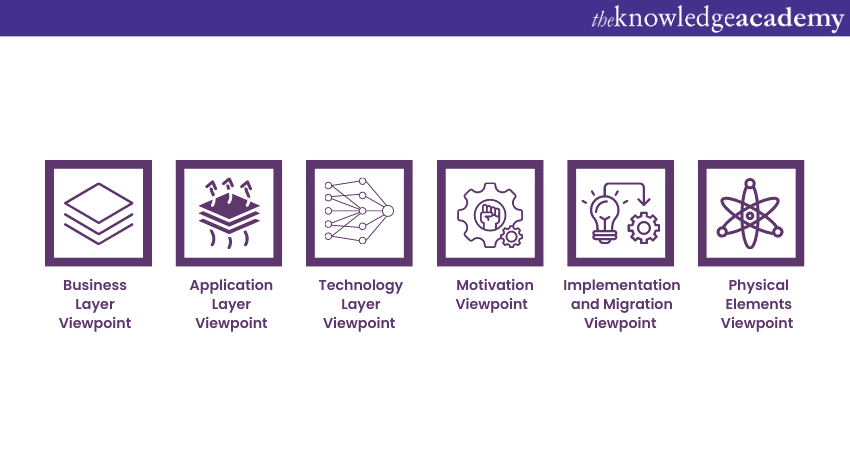
a) Business Layer Viewpoint
The Business Layer Viewpoint focuses on business processes, functions, roles, and organisational structures. It is crucial for aligning IT strategies with business goals and understanding how technology supports business operations.
Imagine a global retail company aiming to streamline its supply chain. The Business Layer Viewpoint would depict the various business processes involved, such as order processing, inventory management, and logistics coordination. Roles and responsibilities, such as sales managers and warehouse staff, would be illustrated. This viewpoint helps identify bottlenecks, improve efficiencies, and optimise the supply chain.
b) Application Layer Viewpoint
The Application Layer Viewpoint explores software applications and their interactions. It focuses on how applications support business processes and how they interact with each other.
In the banking sector, consider a scenario where customers perform online transactions, access account information through a mobile app, and receive notifications. The Application Layer Viewpoint would showcase the applications involved, their functionalities, and their integration points. This viewpoint assists in evaluating application compatibility, identifying potential integration challenges, and ensuring a seamless customer experience.
c) Technology Layer Viewpoint
The Technology Layer Viewpoint addresses infrastructure and technology components required to support applications. It covers hardware, software, networks, and their configurations.
In a healthcare institution, the Technology Layer Viewpoint would illustrate the server infrastructure supporting electronic health records (EHR) systems, network connections ensuring secure data transmission, and databases storing patient information. This viewpoint aids in assessing technology dependencies, scalability, and ensuring compliance with security standards.
d) Motivation Viewpoint
The Motivation Viewpoint captures stakeholder motivations, goals, and requirements. It provides insights into the drivers behind architectural decisions and changes.
Consider a government agency implementing a digital transformation initiative to improve citizen services. The Motivation Viewpoint would detail the agency's goals, such as enhancing citizen engagement and reducing administrative overhead. It would also outline stakeholders' motivations, like improving efficiency and transparency. This viewpoint guides the alignment of architectural choices with the agency's overarching objectives.
e) Implementation and Migration Viewpoint
The Implementation and Migration Viewpoint addresses architectural change and transformation over time. It outlines the transition from the current state to the desired future state.
A manufacturing company decides to replace its legacy inventory management system with a modern solution. The Implementation and Migration Viewpoint would map out the stages of the migration process, including data migration, testing, and deployment. This viewpoint helps manage risks, allocate resources effectively, and ensure a smooth transition without disrupting operations.
f) Physical Elements Viewpoint
The Physical Elements Viewpoint represents the physical aspects of an architecture, including devices, facilities, and distribution networks. It's essential for understanding the physical infrastructure required to support the system.
For a smart city project, the Physical Elements Viewpoint would illustrate the deployment of sensors, cameras, and communication infrastructure across urban areas. This viewpoint aids in planning the placement of physical components, ensuring optimal coverage, and maintaining the reliability of the smart city infrastructure.
Level up your ArchiMate® 3.1 Training Course: Level 2 – Uncover the full potential of architectural mastery!
Mastering the ArchiMate Layered Viewpoint
The ArchiMate Framework's Layered Viewpoint is a fundamental perspective that provides a structured approach to visualising and understanding enterprise architecture. This viewpoint is particularly valuable for architects and stakeholders seeking to comprehend the hierarchical structure and interdependencies within a complex system.
The Layered Viewpoint divides an architecture into distinct layers, each representing a different aspect or category of components. These layers provide a clear separation of concerns, allowing architects to address specific challenges within each layer without losing sight of the larger picture. The layers are interrelated, forming a cohesive whole that represents the holistic architecture.
Benefits of the Layered Viewpoint
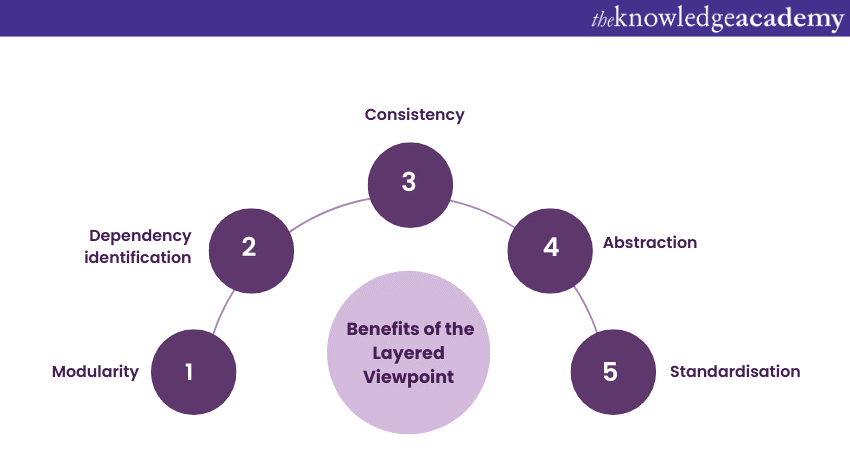
The Layered Viewpoint in ArchiMate brings invaluable benefits to architectural analysis and communication:
a) Modularity: Clearly separates architectural elements into distinct layers, aiding in managing complexity and enhancing the ease of modification.
b) Dependency identification: Highlights dependencies and interactions between layers, enabling architects to understand the impact of changes on the entire architecture.
c) Consistency: Promotes consistency by providing a structured framework for designing and evolving the architecture across layers.
d) Abstraction: Simplifies communication with stakeholders by presenting high-level insights without delving into intricate details.
e) Standardisation: Offers a widely recognised approach that enhances collaboration among architects and stakeholders, fostering a common understanding of the architecture.
Creating Layered Viewpoint diagrams
Creating effective Layered Viewpoint diagrams involves a systematic approach. Begin by identifying the layers relevant to your architecture. These may include the business layer, application layer, and technology layer. For each layer, identify the key components and their relationships within that layer. Then, showcase how these components connect across layers.
Consider an e-commerce platform as an example. The business layer could encompass user interactions and order processing. The application layer might include Customer Relationship Management (CRM) systems and payment gateways. The technology layer would involve servers and databases. A Layered Viewpoint diagram would illustrate how user interactions in the business layer flow through the CRM systems in the application layer and are stored in the databases in the technology layer.
Mastering the ArchiMate Layered Viewpoint equips architects with a structured approach to dissecting and analysing complex architectures. The benefits of modularity, dependency identification, and technology stack clarity are invaluable in creating robust and adaptable systems. By adeptly utilising this viewpoint, architects can ensure that their architectural designs are not only comprehensive but also optimally aligned with the goals of the organisation.
Elevate your architecture skills with our ArchiMate® 3 Training Course –Join now and transform your approach!
Advanced techniques for ArchiMate Viewpoints
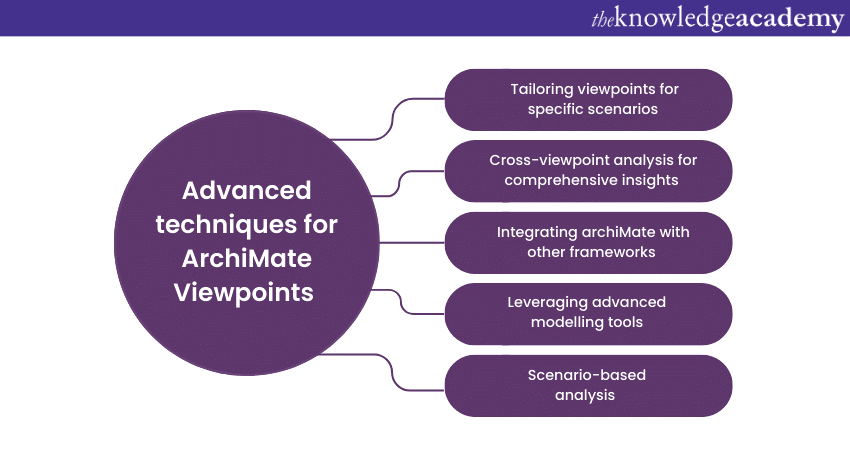
Once you have the foundational understanding of ArchiMate Viewpoints, you can always move on to advanced techniques that can elevate your enterprise architecture practice to new heights. These techniques enable architects to tailor their approach to address unique challenges, gain deeper insights, and integrate ArchiMate with other frameworks for a holistic analysis.
a) Tailoring Viewpoints for specific scenarios
While ArchiMate offers a comprehensive set of viewpoints, there may be scenarios where a standard viewpoint doesn't perfectly align with your specific architectural concerns. In such cases, advanced architects can tailor existing viewpoints or even create custom viewpoints to address these unique challenges. For instance, if you're working on a complex merger, you might modify the Motivation Viewpoint to highlight stakeholder motivations and potential conflicts.
b) Cross-Viewpoint analysis for comprehensive insights
To gain a comprehensive understanding of your architecture, advanced architects can employ cross-viewpoint analysis. This involves combining insights from multiple viewpoints to uncover intricate relationships and dependencies that might not be immediately apparent. By comparing information from the Business, Application, and Technology viewpoints, for instance, you can identify how changes in business processes impact software applications and underlying technology components.
c) Integrating ArchiMate with other frameworks
Advanced architects often work in multi-framework environments, and integrating ArchiMate with other frameworks can provide a more holistic perspective. Techniques like mapping ArchiMate concepts to elements in frameworks like TOGAF (The Open Group Architecture Framework) or BPMN (Business Process Model and Notation) can facilitate seamless alignment between different perspectives. This integration enables architects to harness the strengths of various frameworks and achieve a more comprehensive analysis. Learning about the benefits of TOGAF vs. Archimate will help you gain insights into their respective frameworks, methodologies, and modeling capabilities
d) Leveraging advanced modelling tools
While creating ArchiMate Views manually is a fundamental skill, using advanced modelling tools can significantly enhance efficiency and analysis capabilities. Many tools offer automation features that allow architects to generate views based on predefined rules, ensuring consistency and reducing manual effort. These tools often support exporting views to various formats, facilitating communication with stakeholders who might not be familiar with the intricacies of ArchiMate.
e) Scenario-based analysis
Advanced techniques involve applying viewpoints to specific scenarios or hypothetical situations. This technique enables architects to explore "what-if" scenarios, assess potential risks, and evaluate the impact of different decisions. For instance, using the Implementation and Migration viewpoint, architects can simulate the effects of introducing a new technology or process and predict how it would affect the architecture.
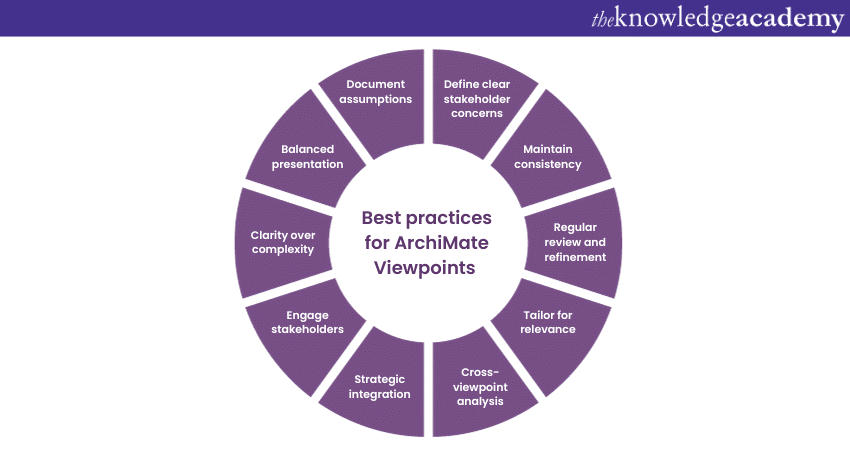
Incorporating these best practices empowers architects to create ArchiMate Viewpoints that not only communicate complex architectural concepts effectively but also foster collaboration and alignment among stakeholders.
a) Define clear stakeholder concerns: Begin by understanding the information needs of stakeholders. Clearly define their concerns and objectives to align viewpoints with their requirements.
b) Maintain consistency: Adhere to consistent terminology, symbols, and notations across viewpoints. This fosters coherence and avoids confusion among stakeholders.
c) Regular review and refinement: Architectural views are dynamic. Regularly review and refine viewpoints to ensure their relevance, accuracy, and alignment with evolving needs.
d) Tailor for relevance: Tailor viewpoints to specific scenarios. Select and adapt viewpoints to address unique architectural challenges and cater to distinct stakeholders.
e) Cross-viewpoint analysis: Combine multiple viewpoints for cross-analysis. This reveals intricate relationships, dependencies, and insights that individual viewpoints may not capture.
f) Strategic integration: Integrate ArchiMate Viewpoints with other architectural frameworks or methodologies for a comprehensive understanding of complex systems.
g) Engage stakeholders: Involve stakeholders throughout the viewpoint creation process. Their input ensures that views effectively address concerns and deliver value.
h) Clarity over complexity: Strive for clarity in diagrams. Avoid overwhelming visuals with excessive details, focusing on conveying essential information succinctly.
i) Balanced presentation: Strike a balance between providing comprehensive information and maintaining view clarity. Prioritise relevant insights over exhaustive details.
j) Document assumptions: Document any assumptions made during viewpoint creation. This aids in transparency and supports informed decision-making.
Conclusion
ArchiMate Viewpoints are not just another feature of the framework; they are the key to unlocking the true potential of enterprise architecture. By following this step-by-step guide, you've embarked on a journey that has demystified the intricacies of viewpoints, from their significance to their practical application. As you continue refining your skills, remember that mastery of ArchiMate Viewpoints is a continuous process, enabling you to orchestrate the symphony of architectural communication and insight in the ever-evolving landscape of enterprise architecture.
Unlock your architectural potential with comprehensive ArchiMate® Training – Empower your expertise today!
Frequently Asked Questions
Upcoming Business Improvement Resources Batches & Dates
Date
 ArchiMate® 3 Training Course
ArchiMate® 3 Training Course
Thu 16th Jan 2025
Thu 6th Mar 2025
Thu 22nd May 2025
Thu 24th Jul 2025
Thu 25th Sep 2025
Thu 20th Nov 2025
Thu 11th Dec 2025







 Top Rated Course
Top Rated Course


 If you wish to make any changes to your course, please
If you wish to make any changes to your course, please


